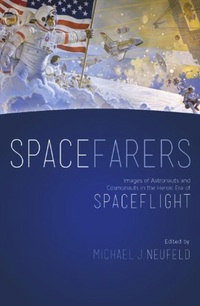Review: Spacefarersby Jeff Foust
|
| One essay looks at the development of the belief that test pilots were the ideal astronauts, even if flying a jet plane was very different from a capsule (or, as those astronauts preferred, “spacecraft,” since as Michael Collins put it, “capsules are swallowed.”) |
Fifty years ago, such a response would have been unthinkable: the astronauts, particularly the original Mercury Seven, were household names. There were, of course, fewer astronauts to keep track of, but they were also front and center in the news, part of the great Space Race between the US and USSR that characterized the early years of the Space Age. This is what Michael Neufeld of the National Air and Space Museum calls the “heroic era” of human spaceflight in his introduction of the new book Spacefarers, a compilation of essays on the subject that grew out of a 2011 conference on the history of human spaceflight organized by the NASA History Office. This period, which Neufeld defines as extending until the Challenger accident in 1986, was heroic “both for the media representation of their image and the actual danger of their occupation,” he writes, referring to astronauts and cosmonauts.
The nine essays in Spacefarers are divided into three groups of three each. The first group examines the development of the heroic age of human spaceflight in the US. A pair of television series, each running for one season in 1959–60, offered the first realistic examinations of human spaceflight, making a sharp break from space operas of the past and creating expectations for the real human missions into space that were about to start. Other essays look at the development of the belief that test pilots were the ideal astronauts, even if flying a jet plane was very different from a capsule (or, as those astronauts preferred, “spacecraft,” since as Michael Collins put it, “capsules are swallowed.”) Those early test pilot astronauts, another essay argues, were like the rugged individual explorers of the American West, clearing the way for the more diverse future classes of astronauts, who were likened to the settlers of the frontier.
The second group of essays examines perceptions of this heroic age outside of the US, particularly in the Soviet Union. Andrew Jenks, who wrote a scholarly biography of Yuri Gagarin (see “Review: The Cosmonaut Who Couldn’t Stop Smiling”, The Space Review, July 2, 2012), examines how Gagarin is remembered in post-Soviet Russia: still revered in his hometown, but in Moscow, the former Cosmonaut Pavilion had by 2007 become a “flea market for gardening supplies” with a picture of Gagarin “covered by a frayed tarp as if to hide the shame of the pavilion’s shabby state from the cosmonaut’s gaze.” During those Space Race glory days, both the US and USSR published magazines in each others’ countries, another essay notes; despite the ideological differences of the two nations, they often depicted their spacefarers in similar ways. In France, the magazine Paris Match took its own approach to covering American and Soviet space efforts (and, later, flights of French “spationauts” on both Soyuz and Space Shuttle flights), trying to humanize the technologies and people behind them.
| Astronauts may not seem as “heroic” today as they did a half-century ago, even if spaceflight remains a risky endeavor. |
The last set of essays moves ahead into the shuttle era, as that heroic era wanes. One essay examines the introduction of women into the astronaut corps in 1978 and their first flights as they dealt with “blatant sexism” in the media. Another shows how spaceflight was brought to the public in a new way with the use of IMAX cameras on several shuttle missions, resulting in a string of IMAX films seen by millions over the last three decades. A final essay contrasts the portrayal of astronauts in Tom Wolfe’s “nonfiction novel” The Right Stuff with a more recent novel, Challenger Park, that examines a shuttle-era female astronaut’s struggles to balance her personal and professional lives (see “Review: Challenger Park”, The Space Review, April 24, 2006).
A relatively brief collection of essays can’t provide a comprehensive examination of how the public viewed early astronauts and cosmonauts, but Spacefarers does offer a broad examination of the topic that Neufeld, writing in the introduction, hopes stimulates further work. (One area not touched upon in this book that could offer an interesting contrast is a comparison of Chinese views and coverage of their rising human spaceflight program with those in America and Russia at similar phases of development.) Astronauts may not seem as “heroic” today as they did a half-century ago, even if spaceflight remains a risky endeavor. However, this book illustrates how that may not be such a bad thing, as the astronaut corps becomes more diverse and thus more like society in general, a trend that may accelerate as suborbital and orbital commercial human spaceflight systems enter service in the next several years. If that shift towards greater numbers of, and greater diversity in, people flying in space means individual spacefarers are a little more anonymous, it may be a trade work making.
